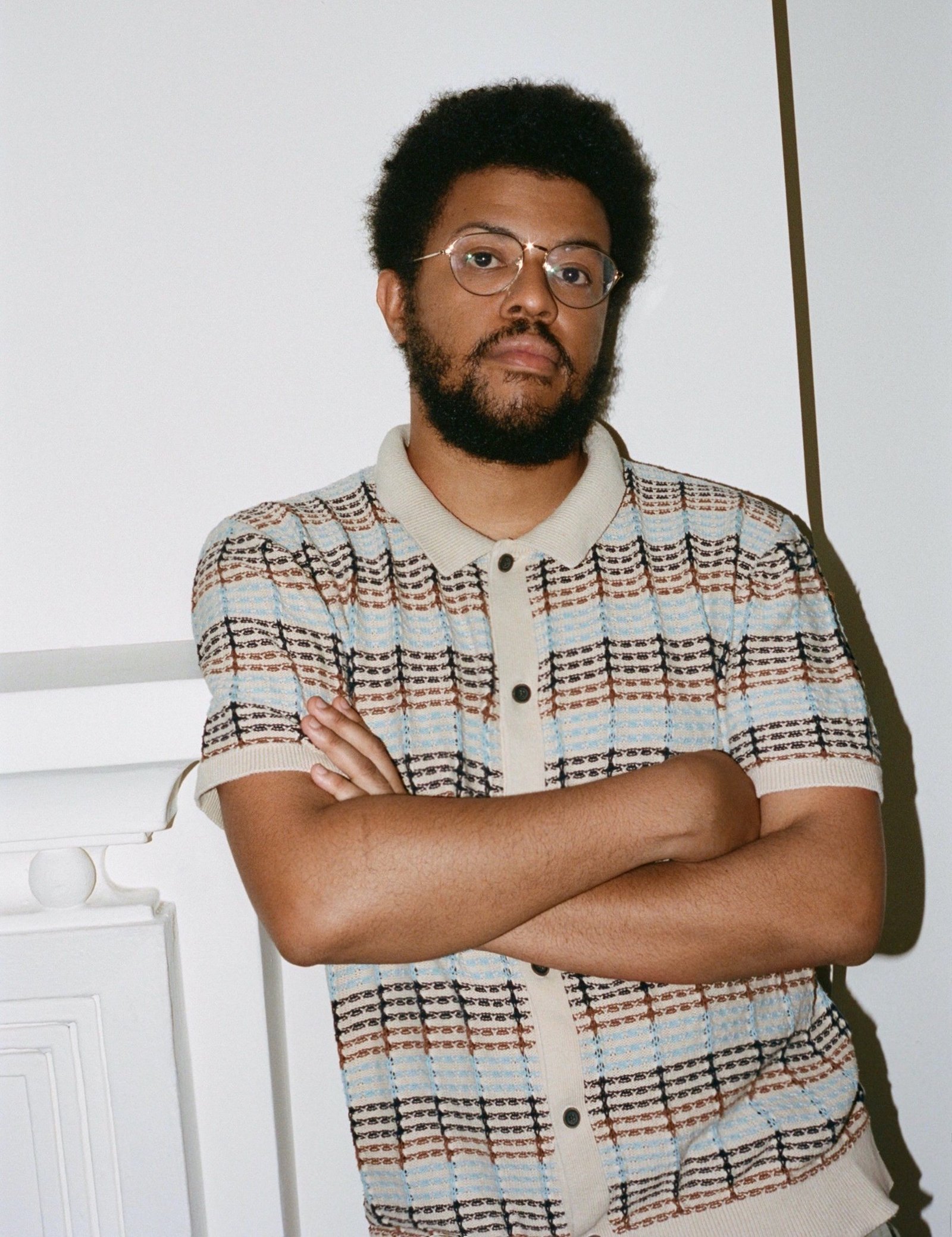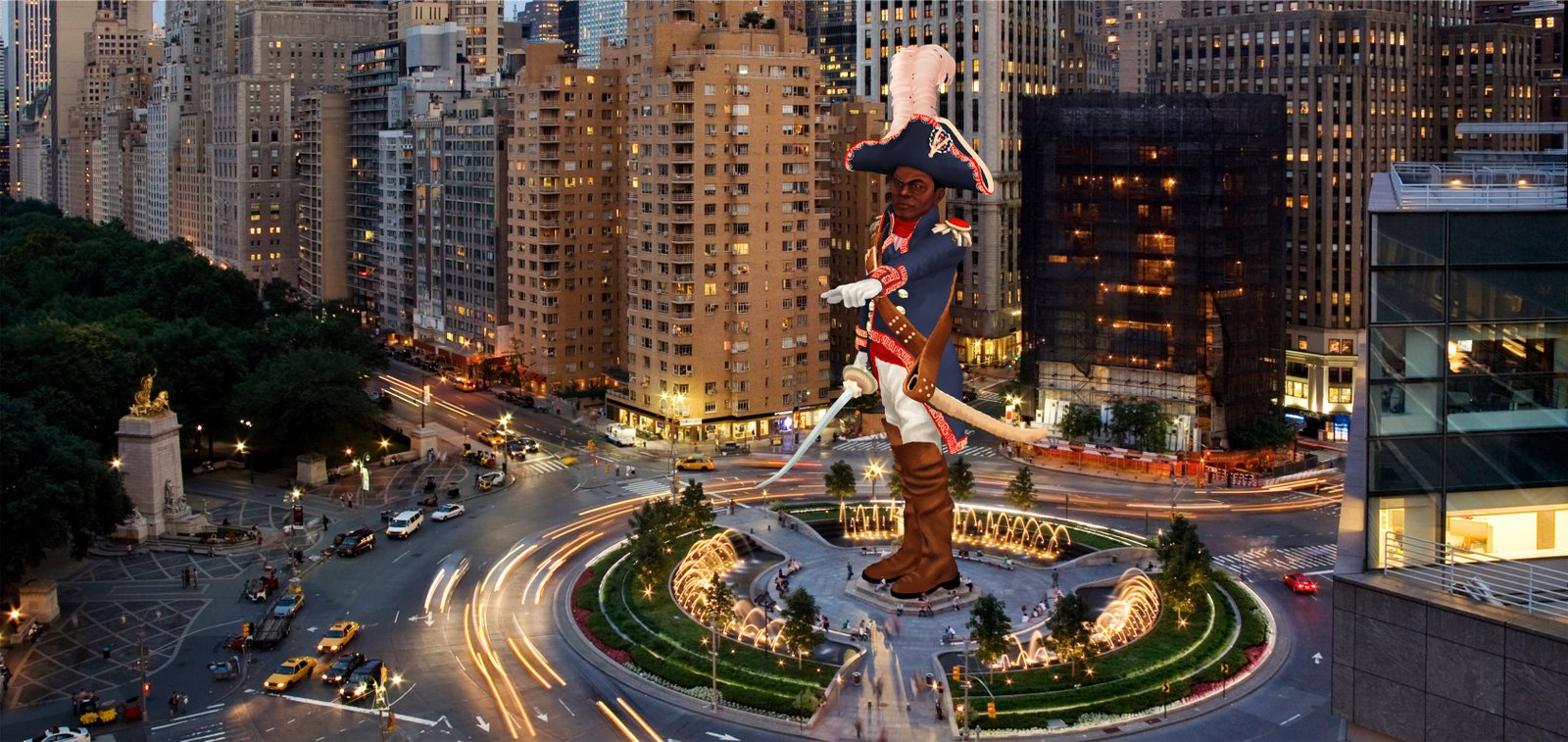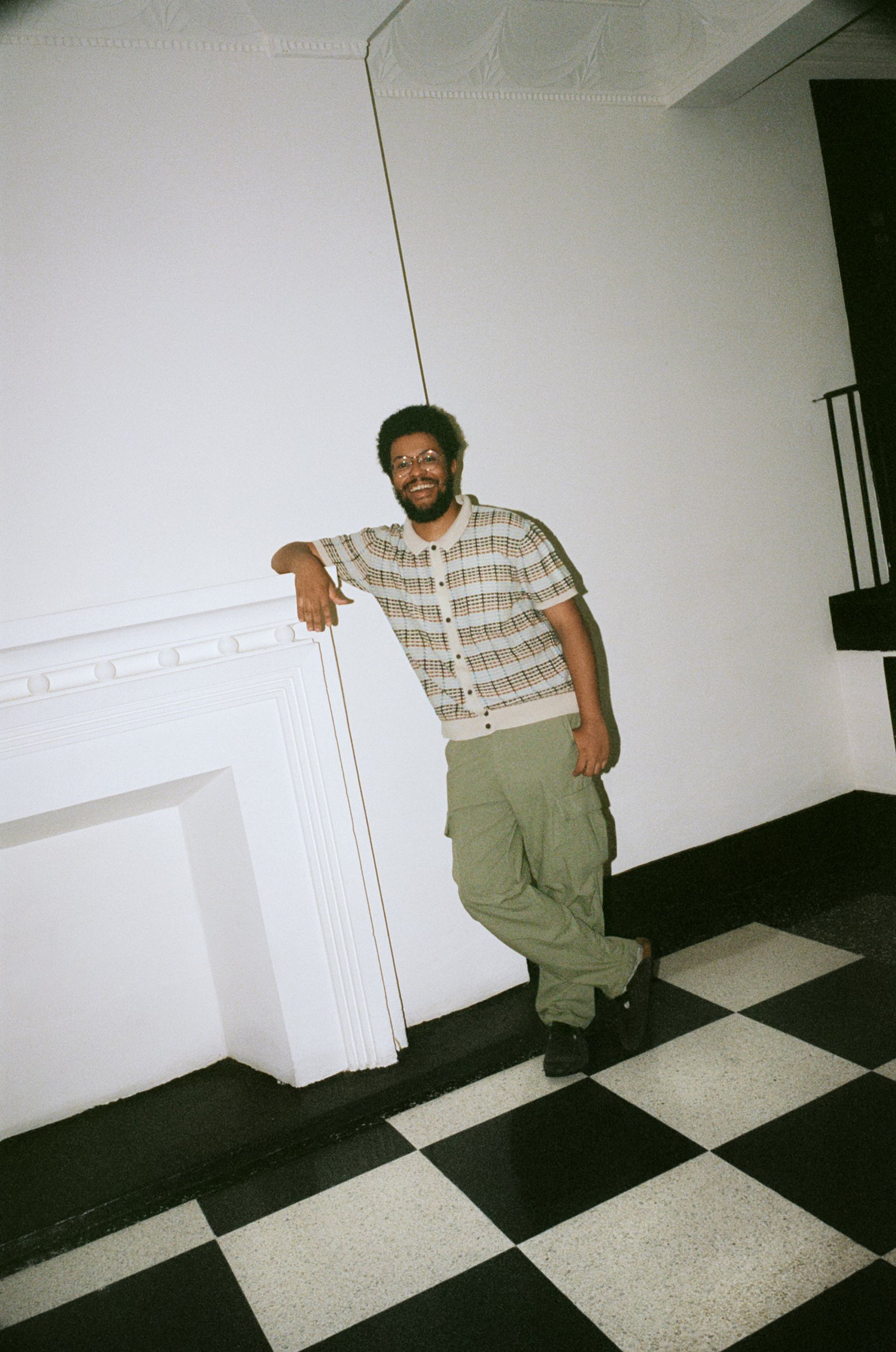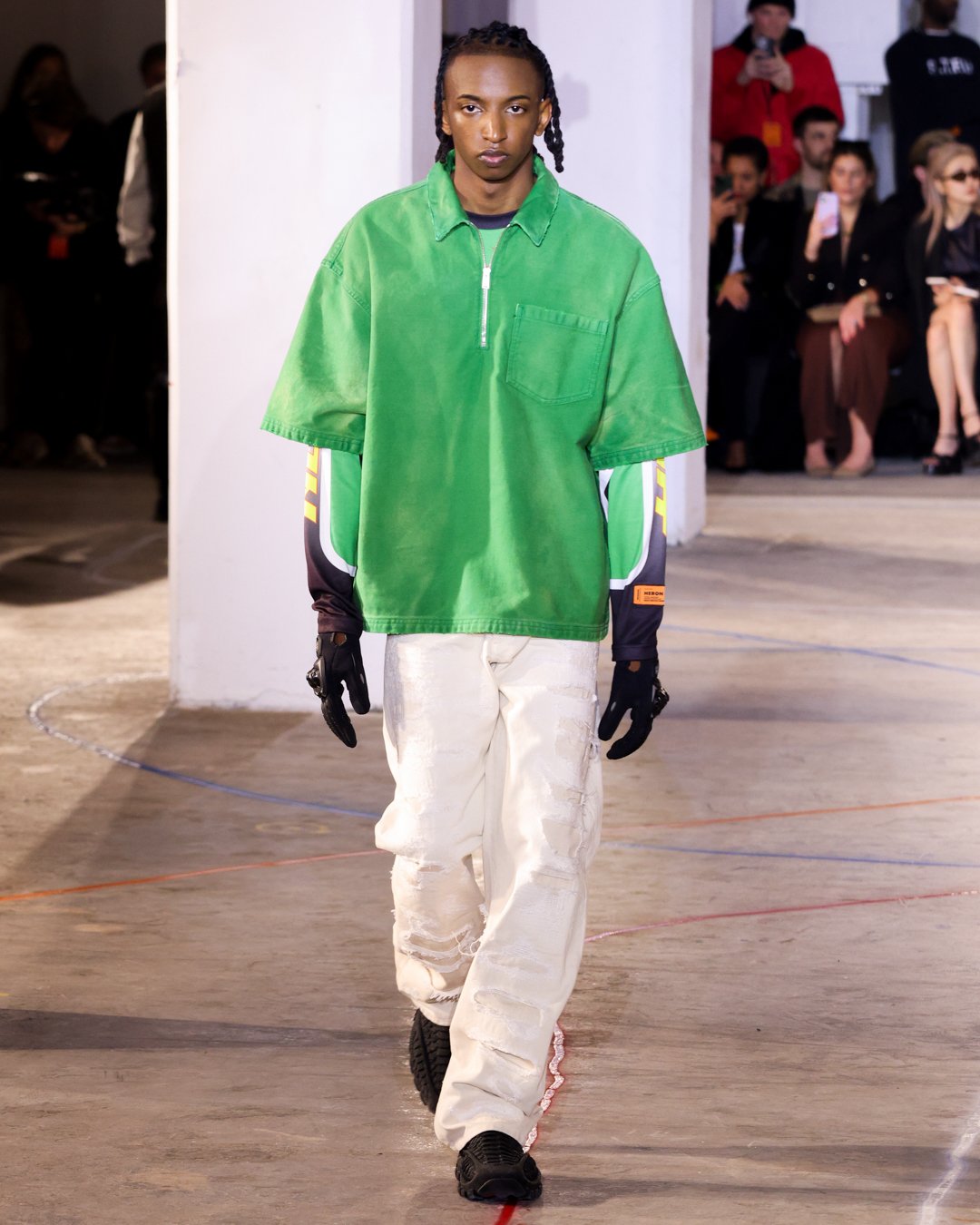Building an archive for the future with Idris Brewster
Idris Brewster, co-founder of Kinfolk, an augmented reality archive of Black and Brown history, is using the intersections of art and technology to radically re-educate America about its past.
Photography Bryce Thomas
Text Jonathan Jayasinghe

Idris Brewster in Brooklyn, New York.
A colossal statue of the Haitian revolutionary Toussaint Louverture. An evocatively lit rendering of the early abolitionist David Ruggles. A dynamic tableau of members of the Puerto Rican/Dominican/Afro-Latino civil rights organization The Young Lords. These are three of the many augmented reality monuments created by the Kinfolk Foundation, currently featured in the MoMA’s exhibition, Architecture Now, New York, New Publics. When regarding these works (viewable through Kinfolk’s app for iOS and Android), one is initially struck by their scale, their artistry and the visual and technical spectacle of their mixed reality medium. But deeper reflection prompts questions such as: What is the role of a monument in contemporary society? What narratives does our built environment prioritize? Who gets to occupy public space?
These questions lie at the heart of Kinfolk’s purpose as an educational technology nonprofit, highlighting the untold stories of Black and Brown historical figures through cutting edge tech. Led by artist, educator and creative technologist Idris Brewster, the organization occupies a singular space at the intersection of art, technology and social justice. Their work redefines what a monument can be through deep community engagement, visual artistry, and a commitment to providing education, context and nuance around the monuments themselves.
We recently caught up with Idris for a conversation about the origins of Kinfolk, the works featured in the MoMA exhibition, and the future of the organization.
JJ: Could you start by telling us a bit about your background, and the early interests that led you to your current work at the intersection of art, activism and tech?
IB: Yeah, I'm a bit of a hodgepodge. I'm a digital artist, hip-hop musician, educator, and I've been in and around film my whole life. I was part of a documentary called American Promise, that followed me for like 13 years, and was about the lives of two Black boys going to a majority white private school. From a young age, I was always thinking about being an ‘other’, about how I fit in or didn't fit in. So I guess I've always had a critical lens around what it means to be a person of color in America. And my background was in art and I asked myself, ‘What can I do with my skills and my passions to contribute to a better society and the betterment of Black folks around the country?’
So I found a lane that was sort of thinking about the future, thinking about technology, and how these things intersect with art and social justice. So I like to say I'm a bridge between a bunch of different people and organizations, and I think Kinfolk is a representation of that.
“when the Charlottesville riots happened and all these white people were coming with their tiki torches to fight against the removal of a Confederate monument… I mean… They lost the war...”
JJ: What’s your earliest memory of recognizing the power of a monument?
IB: Well, I always knew that art had a liberatory and storytelling capacity to it. But I think that, when the Charlottesville riots happened and all these white people were coming with their tiki torches to fight against the removal of a Confederate monument… I mean… They lost the war and they're out here putting up these statues to capture whatever feeling of victory or control over history that they could. For me, witnessing that was a pretty eye opening experience. It speaks to the fear that’s behind the building of these monuments, the fear that those in power have and how monuments are tools of control, to maintain power and control our imagination.
This was compounded by what was happening in New York at around the same time, where the city was trying to figure out what to do with its Christopher Columbus monument. For myself and I'm sure many others, there was no reason for this monument to exist. Myself, and the people I work with, we were doing protests, community demonstrations, bringing our AR experiences to these public spaces to highlight the true story of Christopher Columbus. But with the power of the Italian community and the government here, they ended up landmarking it. There was a lot of pushback towards things that, for me, just seemed normal and needed to happen. It just cemented for me that my philosophy, the philosophy of equity for Black and Brown communities, wasn't being prioritized on a national scale and that we needed to do something about it.
Also, there were a lot of legal challenges with the work of getting the monuments removed, but there was no legal precedent for engagement in terms of digital assets or digital art on physical, public property. And so that was a light bulb moment for us, the fact that the law had not yet caught up. We realized we don't have to go through the hoops of getting permission from the city or government or institutions, and we could work with communities to build these experiences that we can put up anywhere and people can’t tell us anything.

Kinfolk. The Monuments Project. 2022. An augmented-reality monument in honor of General Toussaint Louverture on Columbus Circle.
JJ: Could you tell us about the process by which specific figures or moments are selected to become monuments and the process of bringing them to life?
IB: So it's not just me out here building these monuments, we've got a team. Micah Milner is really the genius behind the 3D work that we've done, and figuring out how to build monuments and make them accessible. Jasmine Maze has been leading the educational portion of what we're doing. In the beginning, we were just building what we wanted to see. We wanted to see Toussaint Louverture, cause I'm Haitian, and we're like alright, let's build that. We chose monuments that were firstly important to us, because with AR, it was still hard to get people to understand what we were doing. We had to show what we could do. So we were just choosing monuments, building them and then bringing them out into public spaces. From there we got a few residencies and grants that enabled us to really focus the work, and it’s there that the community engagement process started to form.
What the process looks like now is us going into communities, finding a local partner that we can work with who really knows their city and can help us build trust, and working with them to engage with the communities and understand who they might want to celebrate. That process of selection has happened in the form of surveys, town halls, social media engagement, and selection committees.
We've had selection committees of folks who are experts in these histories and have helped us to create an ongoing list of figures we want to celebrate. This work is long-term, 10 plus year work. We continue to build the list of monuments that we want to make, and then when we're going into a community, we show them the list to see if any of the figures resonate. We also take surveys to see which ones would make sense to build now versus later, because it's not about going into a community, building monuments, and then dipping. It's about building a foundation for us to engage with that community long-term.
From there, we find artists from those communities; sculptors, painters, conceptual artists, quilt makers, who help creative direct the monument. And then the 3D team, led by Micah, takes that art direction and turns it into reality. The process starts with sketches, which we develop with the artists and the partners we're working with and really get their input because, I mean, we're building monuments. Monuments are representative of histories that are extremely sensitive and extremely important to the communities they exist in. So there's an element of detail and thought that needs to go into them because we're representing some things that aren’t highlighted as much, and the works often become one of the main places where people learn about these figures. And from there, we put that into the app and that can be engaged wherever you are. You can make a whole gallery in your own space. You can be chilling with Shirley Chisholm.
JJ: There’s also a quite robust educational layer to the work as well.
IB: One thing that the digital space offers that physical space doesn't is context and nuance. And so if you see a physical monument, you see an 80-foot tall Christopher Columbus and you're thinking, “Oh, this is one of the most important historical figures and a really great person.” We try to break down that barrier of mythmaking. Every individual is complex and I think our app allows people to understand these figures at a human level through the context that we add. We try to add different perspectives that aren't currently out there. There's artifacts that we add into the app; written biographies, paintings, audio recordings, videos, historical documents. It's about showing these artifacts so people can really dive deep if they want to. We also like to curate resources that can extend people's learning with more contemporary materials like podcasts, videos, articles, movies, playlists.
Public education is really the utmost priority to us and all of this work is to support that. If you look at Florida, Alabama, Texas… They're banning the teaching of our histories. That’s another benefit of working outside of organizations and institutions. We've had a school board not allow our app to be used in the classroom, but the information remains accessible in a way that ultimately can't be censored by the government. Being able to provide public education around these that can also be utilized in classrooms is extremely important because when we first released, teachers were the main people that were using this. So for us it was about providing an aligned curriculum to go with each of our monuments. We have a Black Radical Imagination curriculum that follows figures like George Clinton, Sun Ra, Octavia Butler and others. We have PDFs and documents online that enable people to take these monuments, bring them into their classroom or their informal learning spaces, community spaces, or home schooling as a way to teach this radical history, but also make sure that they’re preparing their students and kids to be able to hit standards and improve their reading.
“We’ll create dances like the Renegade that then get used in Fortnite but we’re not getting paid.”
JJ: There’s been a lot of rapid advancement in digital spaces and tools in the past few years; the metaverse, Web3, mixed reality, and so on. But a lot of these spaces are being shaped by the same colonialist and capitalist impulses as our physical world, which makes work like Kinfolk’s feel all the more vital at this time. How do you see Kinfolk’s work in the context of the broader landscape of emerging tech?
IB: I mean, someone's gotta be the voice to be like, let's slow the hell down for a second. Technology has liberatory possibilities, but as it stands right now, technology is part of an oppressive system that’s just replicating the inequities of our physical reality.
Places like Meta, all these big tech companies, they have one goal and that's financial gain and extraction. There's this vision of the metaverse that's these isolated digital spaces, where you can be fully immersed in these cartoonish worlds and be anyone you want. But I think the vision of the metaverse for Kinfolk is a space where technology can help bring you closer to nature, closer to other people, and it's a shared space. I don't see that vision out there, and that's why we choose AR. AR is through the camera. It's digital technology and art but through a real world perspective. You're never fully immersed, you're not isolated from the world. I think there’s a danger that technology is becoming a space that just further isolates individuals. It's a contradiction that I find myself in. I'm a technologist and an app maker, but I'm trying to find ways to get off my phone. I'm trying to find ways to get in community, be with people. We're trying to build something that facilitates that. That's why events and community-building are a huge part of what we do because if we're building things that further divide us, that's just further exacerbating the issue.
So much of the tech we use, like Instagram, Twitter… We are the motors that keep these mega-corporations running. We create the content. We’ll create dances like the Renegade that then get used in Fortnite but we’re not getting paid. I mean there's so many instances of us creating the cultural capital that turns into actual capital for these white tech companies. So how can we reclaim that capital? We want to provide kids the tools to build the future, build their own Twitter, their own Instagram, and Kinfolk coming into community spaces and demonstrating this technology built by Black people is liberatory in itself.

Idris Brewster photographed at home in Brooklyn, New York.
JJ: Kinfolk is part of a new exhibition at the MoMA called Architecture Now: New York, New Publics. This feels like a major milestone for the organization. Tell us about the work that’s in the exhibition and the impact that it’s been having.
IB: It is a major milestone. When they first reached out, I was like, “Wait, let's run that back. Let's read this again!” For me it was like, I'm a designer, not an architect. But I am thinking about public space. So I'm glad that they were forward thinking enough to include technology in this exhibition. The work that’s in the show, it speaks to what we aspire to do. We want to unearth history that people normally aren’t aware of. We want to unearth histories of place and repair Black, Indigenous, Latinx folks’ relationship with the lands that we've stewarded and built.
It's the relationship between the past, present and future, the relationship between the physical and the digital. That's the space that we occupy and that is why we chose the narratives we chose to include in the exhibition. We found these 300 year old red maple trees, which existed in the 1800s, the time when the narratives we're highlighting actually took place. The app recognizes these trees and that's where the digital monuments grow from.
We focused on Seneca Village, which was a free Black community in Manhattan that was destroyed to make way for the building of Central Park. Downtown Manhattan was one of the hubs of the slave trade in the US, and had a lot of strife and violence that Black folks were trying to escape. So they saw Uptown, which was the countryside at that point, as an escape. They were able to buy these plots of land and form their own communities. They had churches, schools, gardens, pig pens, just had their own community. The city of New York wanted to build its park, so they basically paid these people nominal fees, in some cases no money at all and evicted them from that space and built Central Park over it.
So when we're talking about Architecture Now: New York, New Publics, my question is, who is this public space for? It's clear that one of the premier representations of public space in the World, Central Park, was built over on top of the backs of Black folks, and clearly these public spaces in New York City aren't built for us. So that's why we decided to highlight Seneca Village.
We also highlighted David Ruggles, who was one of the first versions of a modern abolitionist. He lived in downtown Manhattan off Lispenard St. in Tribeca, and he freed over 600 slaves. Slavery was abolished in New York by that time, but people were still practicing slavery. Sometimes folks were taken back after being free, taken back down South. So he would travel down there and free them on ships and on trains. He was like a real life Batman. We’re just trying to highlight stories that people hadn't necessarily heard of before. Seeing people look at David Ruggles, 20-30 feet tall and being admired as the figure that he deserved to be, when people are usually used to seeing white folks revered in that manner, it's been great. We’re getting downloads, we have more exposure than we’ve ever had, it’s great.
“It's clear that one of the premier representations of public space in the World, Central Park, was built over on top of the backs of Black folks...”
JJ: Looking to the future, what’s next for the organization and what are your long-term ambitions for it?
IB: In the immediate future, we have the Tribeca Film Festival, from June 7th to June 17th, where we'll be displaying our newest series called Black Lands. It’s going to be highlighting things like The Land of the Blacks, which was a Black commune that existed in the 1600s and the Pinkster festival, which was a celebratory festival that happened for enslaved and liberated Africans and African-Americans. So I'm really excited for that. I'm also excited for the newest version of Kinfolk that we're planning to release in September, which is the location-based version. We're partnering with Niantic, who built Pokémon Go, to use their technology to help expedite the process of getting this out there. So all of these monuments will be geo-located.
We're also releasing a signature artist series where we'll be working with artists like Hank Willis Thomas, Derek Adams and a few more who we can't talk about just yet. I think we've done a good job at showcasing the historical aspect in monuments, but I think this subject cannot be talked about without the speculative and imaginative aspects of how Black folks, Brown folks, Indigenous folks take history and meld it into this new form with mythology and art. To showcase that is really exciting for me and it's basically a new landscape of digital public art that hasn’t existed before because the technology is just getting to that space now.
If you look at the National Register of Historic Places, only 8% are related to people of color. There's a clear absence of markings and signs and monuments and public pieces that lift up our history. Especially with rapidly gentrifying neighborhoods, there's more and more people who are moving into these spaces with no clue what's what was there before. Part of this is the art and the education, and we're working with schools to get Kinfolk into those schools and field trips going to these places. It's about repairing the relationship between history, communities of color and the land. I think the opportunity that we could provide folks is to easily be able to mark these spaces and use these markings to advocate for physical changes. Because again, a monument is not the end all be all. It's not the destination, it's the vehicle to reach the destination, which is true community change and physical change to our public spaces and education curriculums.
